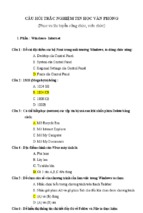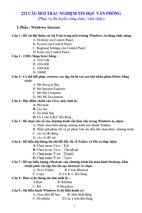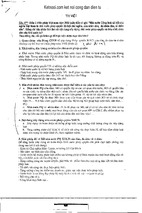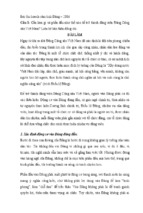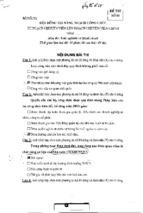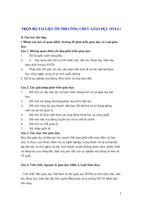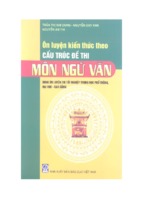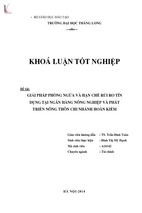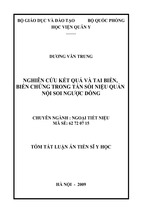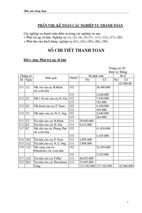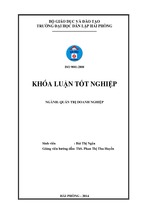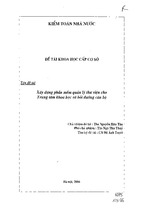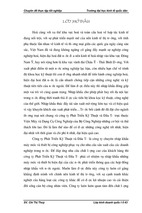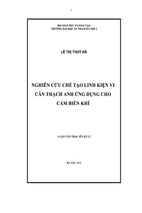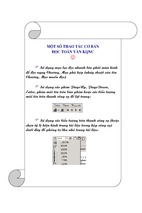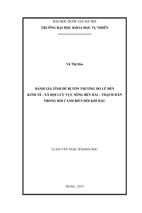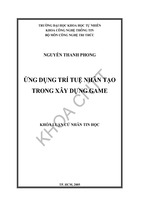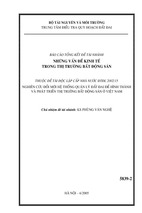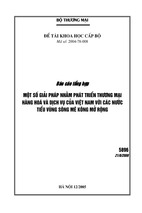Vietnam
Pocket Tax Book 2015
www.pwc.com/vn
Vietnam
Pocket Tax Book 2015
PwC Vietnam
PwC - Vietnam Pocket Tax Book 2015
PwC
2
PwC - Vietnam Pocket Tax Book 2015
Contents
Taxation
General Overview
6
Corporate Income Tax
Tax Rates
Tax Incentives
Calculation of Taxable Profits
Non-deductible Expenses
Losses
Administration
Profit Remittance
7
Transfer Pricing
10
Foreign Contractor Tax
Dividends
Interest
Royalties, Licence fees, etc.
Freight & Transportation Services
Payments to Foreign Contractors
Double Taxation Agreements
11
Capital Assignment Profits Tax
14
Value Added Tax
Scope of Application
Goods and Services not Subject to VAT
Exempt Goods and Services
Tax Rates
Exported Services
VAT Calculation Methods
Discounts and Promotions
Goods and Services Used Internally
Administration
Refunds
Tax Invoices
15
Special Sales Tax
Taxable Price
Tax Credit
Tax Rates
19
Natural Resources Tax
20
Property Taxes
21
Environment Protection Tax
22
Import and Export Duties
Rates
Calculations
Exemptions
Refunds
Export Duties
23
PwC
3
PwC - Vietnam Pocket Tax Book 2015
Personal Income Tax
Tax Residency
Tax Year
Employment Income
Non-employment Income
Non Taxable Income
Foreign Tax Credits
Tax Deductions
PIT Rates
Administration
26
Social, Health and Unemployment Insurance Contributions
29
Other Taxes
30
Tax Audits and Penalties
31
Accounting and Auditing
32
Appendix I – Double Taxation Agreements
33
PwC Services in Vietnam
35
Contacts
36
PwC
4
PwC - Vietnam Pocket Tax Book 2015
A summary of Vietnam taxation
The information in this booklet is based on current taxation regulations and practice including certain
legislative proposals as at 1 April 2015.
This booklet is intended as a general guide. Where specific transactions are being contemplated, definitive
advice should be sought.
PwC
5
Vietnam Pocket Tax Book 2015
Taxation
General Overview
Most business activities and investments in Vietnam will be affected by the following taxes:
Corporate income tax;
Various withholding taxes;
Capital assignment profits tax;
Value added tax;
Import duties;
Personal income tax of Vietnamese and expatriate employees;
Social insurance, unemployment insurance and health insurance contributions.
There are various other taxes that may affect certain specific activities, including:
Special sales tax;
Natural resources tax;
Property taxes;
Export duties;
Environment protection tax.
All these taxes are imposed at the national level. There are no local, state or provincial taxes.
PwC
6
Vietnam Pocket Tax Book 2015
Corporate Income Tax (“CIT”)
Tax Rates
Enterprises (generally companies) are subject to the tax rates imposed under the CIT Law. The standard CIT
rate was reduced from 25% to 22% from 2014 and will be further reduced to 20% from 2016. A 20% rate applies
for enterprises with revenue of no more than VND20 billion in the preceding year. Companies operating in the
oil and gas industry are subject to CIT rates ranging from 32% to 50% depending on the location and specific
project conditions. Companies engaging in prospecting, exploration and exploitation of mineral resources (e.g.
silver, gold, gemstones) are subject to CIT rates of 40% or 50%, depending on the project’s location.
Tax Incentives
Tax incentives are granted to new investment projects based on regulated encouraged sectors, encouraged
locations and the size of the project. Business expansion projects which meet certain conditions are also entitled
to CIT incentives. New investment projects and business expansion projects do not include projects established
as a result of certain acquisitions or reorganisations.
-
The sectors which are encouraged by the Vietnamese Government include education, health care,
sport/culture, high technology, environmental protection, scientific research, infrastructural
development, software production and renewable energy.
-
Locations which are encouraged include qualifying economic and high-tech zones, certain industrial
zones and difficult socio-economic areas.
-
Large manufacturing projects with investment capital of VND6,000 billion or more, disbursed within 3
years of being licensed (excluding those related to the manufacture of products subject to special sales
tax or those exploiting mineral resources) can also qualify for CIT incentives if the projects meet either
of the following criteria:
i.
minimum revenue of VND10,000 billion/annum at least 3 years after the first year of operations;
or
ii. headcount of more than 3,000 at least 3 years after the first year of operations.
From 2015, large manufacturing projects are defined to include projects with investment capital of
VND12,000 billion or more, disbursed within 5 years of being licensed (excluding those related to the
manufacture of products subject to special sales tax or those exploiting mineral resources) and using
technologies appraised in accordance with relevant laws.
Further, new investment projects engaging in manufacturing industrial products prioritized for
development will be entitled to CIT incentives if they meet one of the following conditions:
-
The products support the high technology sector; or
The products support the garment, textile and footwear, IT, automobiles assembly, mechanics
sector and are not produced domestically as at 1 January 2015, or if produced domestically,
they meet the quality standards of the EU or equivalent.
The two common preferential rates of 10% and 20% are available for 15 years and 10 years respectively, starting
from the commencement of operating activities. From 1 January 2015, the preferential rate of 15% will apply in
certain cases. The duration of application of the preferential tax rate can be extended in certain cases. From 1
January 2016, enterprises having projects entitled to the preferential CIT rate of 20% will enjoy the rate of 17%
instead. When the preferential rate expires, the CIT rate reverts to the standard rate. Certain socialised sectors
(e.g. education, health) enjoy the 10% rate for the life of the project.
Taxpayers may be eligible for tax holidays and reductions. The holidays take the form of a complete exemption
from CIT for a certain period beginning immediately after the enterprise first makes profits, followed by a
period where tax is charged at 50% of the applicable rate. However, where the enterprise has not derived profits
within 3 years of the commencement of operations, the tax holiday/tax reduction will start from the fourth year
of operation. Criteria for eligibility for these holidays and reductions are set out in the CIT regulations.
Additional tax reductions may be available for companies engaging in manufacturing, construction and
transportation activities which employ many female staff or employ ethnic minorities.
PwC
7
Vietnam Pocket Tax Book 2015
Tax incentives which are available for investment in encouraged sectors do not apply to other income, which is
broadly defined.
Calculation of Taxable Profits
Taxable profit is the difference between total revenue, whether domestic or foreign sourced, and deductible
expenses, plus other assessable income.
Taxpayers are required to prepare an annual CIT return which includes a section for making adjustments to
accounting profit to arrive at taxable profit.
Non-deductible Expenses
Expenses are tax deductible if they relate to the generation of revenue, are properly supported by suitable
documentation including bank transfer vouchers where the invoice value is VND20 million or above and are
not specifically identified as being non-deductible. Examples of non-deductible expenses include:
Depreciation of fixed assets which is not in accordance with the prevailing regulations;
Employee remuneration expenses which are not actually paid, or are not stated in a labour contract or
collective labour agreement;
Staff welfare (including certain benefits provided to family member of staff) exceeding a cap of one month’s
average salary;
Reserves for research and development not in accordance with the prevailing regulations;
Provisions for severance allowance (except for companies not subject to mandatory unemployment
insurance contributions) and payments of severance allowance in excess of the prescribed amount per the
Labour Code;
Overhead expenses allocated to a permanent establishment (“PE”) in Vietnam by the foreign company’s
head office exceeding the amount under a prescribed revenue-based allocation formula;
Interest on loans corresponding to the portion of charter capital not yet contributed;
Interest on loans from non-economic and non-credit organisations exceeding 1.5 times the interest rate set
by the State Bank of Vietnam;
Provisions for stock devaluation, bad debts, financial investment losses, product warranties or construction
work which are not in accordance with the prevailing regulations;
Unrealised foreign exchange losses due to the year-end revaluation of foreign currency items other than
account payables;
Donations except certain donations for education, health care, natural disaster or building charitable homes
for the poor;
Administrative penalties, fines, late payment interest;
Contributions to voluntary pension funds and the purchase of voluntary pension and life insurance for
employees exceeding VND 1 million per month per person;
Certain expenses directly related to the issuance, purchase or sale of shares;
Creditable input value added tax, corporate income tax and personal income tax.
From 2015, the cap on the tax deductibility of advertising and promotion expenses has been abolished.
For certain businesses such as insurance companies, securities trading and lotteries the Ministry of Finance
provides specific guidance on deductible expenses for CIT purposes.
Business entities in Vietnam are allowed to set up a tax deductible Research and Development fund to which
they can appropriate up to 10% of annual profits before tax. Various conditions apply.
PwC
8
Vietnam Pocket Tax Book 2015
Losses
Taxpayers may carry forward tax losses fully and consecutively for a maximum of five years.
Losses arising from incentivised activities can be offset against profits from non-incentivised activities, and vice
versa. Losses from the transfer of real estate and the transfer of investment projects can be offset against profits
from other business activities.
Carry-back of losses is not permitted. There is no provision for any form of consolidated filing or group loss
relief.
Administration
Provisional quarterly CIT returns are no longer required. Enterprises will instead be required to make quarterly
provisional CIT payments based on estimates. If the provisional quarterly CIT payments account for less than
80% of the final CIT liability, the shortfall in excess of 20% is subject to late payment interest (currently as high
as 18% per annum), counting from the deadline for payment of the Quarter 4 CIT liability.
Final CIT returns are filed annually. The annual CIT return must be filed and submitted not later than 90 days
from the fiscal year end. The outstanding tax payable must be paid at the same time.
Where a taxpayer has a dependent accounting unit (e.g. branch) in a different province, a single CIT return is
required. However, manufacturing companies are required to allocate tax payments to the various provincial tax
authorities in the locations where they have dependent manufacturing establishments. The basis for allocation is
the proportion of expenditure incurred by each manufacturing establishment over the total expenditure of the
company.
The standard tax year is the calendar year. Companies are required to notify the tax authorities in cases where
they use a tax year (i.e. fiscal year) other than the calendar year.
Profit Remittance
Foreign investors are permitted to remit their profits annually at the end of the financial year or upon termination
of the investment in Vietnam. Foreign investors are not permitted to remit profits if the investee company has
accumulated losses.
The foreign investor or the investee company are required to notify the tax authorities of the plan to remit profits
at least 7 working days prior to the scheduled remittance.
PwC
9
Vietnam Pocket Tax Book 2015
Transfer Pricing
Vietnam’s transfer pricing regulations outline various situations where transactions will be considered as being
between related parties and the mechanisms for determining the market “arm’s length” transaction value.
Under the wide ranging definition of related parties, the control threshold is lower than in many other countries
(20%) and the definition also extends to certain significant supplier, customer and funding relationships
between otherwise unrelated parties. Vietnam’s transfer pricing rules also extend to domestic related party
transactions.
The acceptable methodologies for determining arm’s length pricing are analogous to the principles espoused by
the Organisation for Economic Cooperation and Development (OECD), i.e. comparable uncontrolled price,
resale price, cost plus, profit split and comparable profits methods.
Compliance requirements include an annual declaration of related party transactions and transfer pricing
methodologies used, which is required to be filed together with the annual CIT return. For tax years
commencing on or after 1 January 2014, a revised declaration form is required to be completed, which contains
enhanced declaration requirements, specifically requiring companies to declare and self-assess the arm’s length
value of their transactions (or, in the alternative, make a voluntary adjustment).
Companies which have related party transactions must also prepare and maintain contemporaneous transfer
pricing documentation, which is required to be submitted to the tax authorities within 30 working days of a
request, in Vietnamese. There are no de-mininus rules for documentation.
An advance pricing agreement (“APA”) mechanism was introduced in 2014. The GDT is working through the
initial ‘pilot’ APA applications which will allow the taxpayers and the tax authorities to agree in advance the
pricing method and outcomes.
PwC
10
Vietnam Pocket Tax Book 2015
Foreign Contractor Tax (“FCT”)
FCT applies to certain payments to foreign parties including interest, royalties, service fees, leases, insurance,
transportation, transfers of securities and goods supplied within Vietnam or associated with services rendered
in Vietnam, and certain distribution arrangements. It normally comprises a combination of CIT and VAT at
varying rates but can also include PIT for payments to foreign individuals.
Dividends
No withholding or remittance tax is imposed on profits paid to foreign corporate shareholders.
Interest
Withholding tax of 5% applies to interest paid on loans from foreign entities. Offshore loans provided by certain
Government or semi-government institutions may obtain an exemption from interest withholding tax where a
relevant double taxation agreement or inter-governmental agreement applies.
Interest paid on bonds (except for tax exempt bonds) and certificates of deposit issued to foreign entities are
subject to 5% withholding tax. Sales of bonds and certificates of deposits are subject to deemed tax of 0.1% of
the gross sales proceeds.
Royalties and Licence Fees
FCT at 10% applies to payments to a foreign entity for the right to use, transfer intellectual property or for
transfers of technology or software license.
Payments to Foreign Contractors
A withholding tax on payments to foreign contractors applies where a Vietnamese party (including foreign
owned companies) contracts with a foreign entity that does not have a licensed presence in Vietnam.
This FCT generally applies to payments derived from Vietnam, except for the pure supply of goods (i.e. where
the responsibility, cost and risk relating to the goods passes at or before the border gate of Vietnam and there
are no associated services performed in Vietnam), services performed and consumed outside Vietnam and
various other services performed wholly outside Vietnam (e.g. certain repairs, training, advertising, promotion,
etc.).
In addition, certain distribution arrangements where foreign entities are directly or indirectly involved in the
distribution of goods or provision of services in Vietnam are subject to FCT – e.g., where the foreign entity
retains ownership of the goods, bears distribution, advertising or marketing costs, are responsible for the
quality of goods or services, make pricing decisions, or authorises/hires other Vietnamese entities to carry out
part of the distribution of goods/provision of services in Vietnam.
Foreign contractors can choose between three methods for tax payment - the deduction method, the direct
method and the hybrid method.
Method One – Deduction Method
This entails the foreign contractor registering for VAT purposes and filing CIT and VAT returns in the same way
as a local entity. Foreign contractors can apply the deduction method if they meet all of the requirements
below:
They have a PE or are tax resident in Vietnam;
The duration of the project in Vietnam is more than 182 days; and
They adopt the full Vietnam Accounting System (“VAS”), complete a tax registration and are granted a tax
code.
The Vietnamese customer is required to notify the tax office that the foreign contractor will pay tax under the
deduction method within 20 working days from the date of signing the contract.
PwC
11
Vietnam Pocket Tax Book 2015
If the foreign contractor carries out many projects in Vietnam and qualifies for application of the deduction
method for one project, the contractor is required to apply the deduction method for its other projects as well.
The foreign contractor will pay CIT at 22% on its net profits.
Method Two – Direct Method
Foreign contractors adopting the direct (or withholding) method do not register for VAT purposes nor file CIT
or VAT returns. Instead CIT and VAT will be withheld by the Vietnamese customer at prescribed rates from the
payments made to the foreign contractor. Various rates are specified according to the nature of the activities
performed. The VAT withheld by the Vietnamese customer is generally an allowable input credit in its VAT
return.
Separate requirements for FCT declarations under this method are provided for foreign contractors providing
goods and services for exploration, development and production of oil and gas.
Method Three – Hybrid Method
The hybrid method allows foreign contractors to register for VAT and accordingly pay VAT based on the
deduction method (i.e. output VAT less input VAT), but with CIT being paid under the direct method rates on
gross turnover.
Foreign contractors wishing to adopt the hybrid method must:
Have a PE in Vietnam or be tax resident in Vietnam;
Operate in Vietnam under a contract with a term of more than 182 days; and
Maintain accounting records in accordance with the accounting regulations and guidance of the Ministry of
Finance.
The FCT rates are summarised below:
Rates
Industry
Supply of goods in Vietnam or associated with
services rendered in Vietnam (including in-country
import-export and imports, distribution of goods in
Vietnam or delivery of goods under Incoterms where
the seller bears risk relating to goods in Vietnam)
Services
Services together with supply of machinery and
equipment (2)
Restaurant, hotel and casino management services
Construction, installation without supply of
materials, machinery or equipment.
Construction, installation with supply of materials,
machinery or equipment.
Leasing of machinery and equipment
Leasing of aircraft and vessels
Transportation
Interest
Royalties
Insurance
Re-insurance, commission for re-insurance
Transfer of securities
Financial derivatives
PwC
Deemed VAT
rate (3)
1% (1)
Deemed CIT
rate
1%
5%
3%
5%
2%
5%
5%
10%
2%
3%
2%
5%
Exempt (4)
3% (5)
Exempt
Exempt (6)
Exempt/5% (7)
Exempt
Exempt
Exempt
5%
2%
2%
5%
10%
5%
0.1%
0.1%
2%
12
Vietnam Pocket Tax Book 2015
(1) VAT will not be payable where goods are exempt from VAT or where import VAT is paid
(2) Where the contract does not separate the value of goods and services
(3) The supply of goods and/or services to the oil and gas industry are subject to the standard 10% VAT
rate. Certain goods or services may be VAT exempt or subject to 5% VAT.
(4) Where aircraft and vessels cannot be manufactured in Vietnam
(5) International transportation is subject to 0% VAT
(6) Software licenses, transfer of technology, transfer of intellectual property rights are VAT exempt
(7) Certain types of insurance are exempt from VAT (see “Exempt Goods and Services” in VAT section).
Double Taxation Agreements (“DTAs”)
The CIT withholding taxes may be affected by a relevant DTA. For example, the 5% CIT withholding on services
supplied by a foreign contractor may be eliminated under a DTA if the foreign contractor does not have a PE in
Vietnam.
Vietnam has signed up to more than 65 DTAs and there are a number of others at various stages of negotiation.
Please see the summary at Appendix I. Notably absent is a DTA with the United States of America.
Additional guidance has been introduced on the application of DTAs and became effective in 2014. The most
notable and interesting changes relate to beneficial ownership and general anti-avoidance provisions. DTA
entitlements will be denied where the main purpose of the arrangements is to obtain beneficial treatment under
the terms of the DTA (treaty shopping) or where the recipient of the income is not the beneficial owner. The
guidance dictates that a substance over form analysis is required for the beneficial ownership and outlines the
factors to be considered:
-
PwC
Where the recipient is obligated to distribute more than 50% of the income to an entity in a third
country within 12 months;
Where the recipient has little or no substantive business activities;
Where the recipient has little or no control over or risk in relation to the income received;
Back to back arrangements;
Where the recipient is resident in a country with a low tax rate;
The recipient is an intermediary or agent.
13
Vietnam Pocket Tax Book 2015
Capital Assignment Profits Tax (“CAPT”)
Gains derived by an entity on transfers of interests (as opposed to shares) in a Vietnam limited liability
company or other enterprises are subject to 22% CIT. This is generally referred to as capital assignment profits
tax (CAPT) although it is not a separate tax as such. The taxable gain is determined as the excess of the sale
proceeds less cost (or the initial value of contributed charter capital for the first transfer) less transfer expenses.
Where the vendor is a foreign entity, a Vietnamese purchaser is required to withhold the tax due from the
payment to the vendor and account for this to the tax authorities. Where the purchaser is also a foreign entity,
the Vietnamese enterprise in which the interest is transferred is responsible for the CAPT administration. The
return and payment is required within 10 days from the date of official approval of the sale.
Capital assignment with a value of VND 20m or more must be supported by documents evidencing non-cash
payment. If not, the tax authorities have the right to deem the transfer price for CAPT purposes.
Transfers of securities (bonds, shares of public joint stock companies, etc.) by a foreign entity are subject to CIT
on a deemed basis at 0.1% of the total disposal proceeds. Gains derived by a resident entity from the transfer of
securities are however taxed at 22%.
PwC
14
Vietnam Pocket Tax Book 2015
Value Added Tax (“VAT”)
Scope of Application
VAT applies to goods and services used for production, trading and consumption in Vietnam (including goods
and services purchased from non-residents). A domestic business must charge VAT on the value of goods or
services supplied.
In addition, VAT applies on the duty paid value of imported goods. The importer must pay VAT to customs
authorities at the same time they pay import duties. For imported services, VAT is levied via the FCT
mechanism.
VAT payable is calculated as the output VAT charged to customers less the input VAT suffered on purchases of
goods and services. For input VAT to be creditable, the taxpayer must obtain a proper VAT invoice from the
supplier. For VAT paid on imports the supporting document is the tax payment voucher and for VAT collected
via the FCT mechanism, the supporting document is the FCT payment voucher.
Goods or Services where VAT declaration and payment are not required
For these supplies, no output VAT has to be charged but input VAT paid on related purchases may be credited.
These supplies include:
Compensation, bonuses and subsidies, except those provided in exchange for marketing/promotional
services;
Transfers of emission rights and other financial revenues;
Certain services rendered by a foreign organisation which does not have a PE in Vietnam where the services
are rendered outside of Vietnam, including repairs to means of transport, machinery or equipment,
advertising, marketing, promotion of investment and trade to overseas; brokerage activities for the sale of
goods and services overseas, training, certain international telecommunication services;
Sales of assets by non-business organisations or individuals who are not registered for VAT;
Transfer of investment projects;
Sale of agricultural products that have not been processed into other products or which have just been
through preliminary processing;
Capital contributions in kind;
Certain asset transfers between a parent company and its subsidiaries or between subsidiaries of the same
parent company;
Collections of compensation/indemnities by insurance companies from third parties;
Collections on behalf of other parties which are not involved in the provision of goods/services (e.g. if
company A purchases goods/services from company B, but pays to company C and subsequently company C
pays to company B, then the payment from company C to company B is not subject to VAT);
Commissions earned by (i) agents selling services, including postal, telecommunications, lottery,
airlines/bus/ship/train tickets, at prices determined by principals; and (ii) agents for international
transportation, airlines and shipping services entitled to 0% VAT; and (iii) insurance agents;
Commissions from the sale of exempt goods/services.
Exempt Goods and Services
There are stipulated categories of VAT exemption, including inter alia:
Certain agricultural products;
Goods/services provided by individuals having annual revenue of VND 100 million or below;
Imported or leased drilling rigs, aeroplanes and ships of a type which cannot be produced in Vietnam;
Transfer of land use rights (subject to limitations);
Financial derivatives and credit services (including credit card issuance, finance leasing and factoring); sale
of VAT able mortgaged assets by the borrower under the lender’s authorization in order to settle a
guaranteed loan and provision of credit information.
Various securities activities including fund management;
Capital assignment;
Foreign currency trading;
Debt factoring;
PwC
15
Vietnam Pocket Tax Book 2015
Certain insurance services (including life insurance, health insurance, agricultural insurance and
reinsurance);
Medical services;
Teaching and training;
Printing and publishing of newspapers, magazines and certain types of books;
Passenger transport by public buses;
Transfer of technology, software and software services except exported software which is entitled to 0% rate;
Gold imported in pieces which have not been processed into jewellery;
Exported unprocessed mineral products such as crude oil, rock, sand, rare soil, rare stones, etc.;
Imports of machinery, equipment and materials which cannot be produced in Vietnam for direct use in
science research and technology development activities;
Equipment, machinery, spare parts, specialised means of transport and necessary materials which cannot be
produced in Vietnam for prospecting, exploration and development of oil and gas fields;
Goods imported in the following cases: international non-refundable aid, including from Official
Development Aid, foreign donations to government bodies and to individuals (subject to limitations).
Tax Rates
There are three VAT rates as follows:
0%
This rate applies to exported goods/services including goods/services sold to overseas/non-tariff areas
and consumed outside Vietnam/in the non-tariff areas, goods processed for export or in-country export
(subject to conditions), goods sold to duty free shops, certain exported services, construction and
installation carried out for export processing enterprises, aviation, marine and international
transportation services.
5%
This rate applies generally to areas of the economy concerned with the provision of essential goods and
services. These include: clean water; fertiliser production; teaching aids; books; unprocessed foodstuffs;
medicine and medical equipment; husbandry feed; various agricultural products and services;
technical/scientific services; rubber latex; sugar and its by-products; certain cultural, artistic, sport
services/products and social housing.
10% This "standard" rate applies to activities not specified as not-subject to VAT, exempt or subject to 0% or
5%.
When a supply cannot be readily classified based on the tax tariff, VAT must be calculated based on the highest
rate applicable for the particular range of goods which the business supplies.
Exported Goods and Services
Services directly rendered and goods sold to foreign companies, including companies in non-tariff areas, are
subject to 0% VAT if they are consumed outside Vietnam or in non-tariff areas.
Various supporting documents are required in order to apply 0% VAT to exported goods and services (except
for international transportation services): e.g. contracts, evidence of non-cash payment and customs
declarations (for exported goods).
There are a number of services specified in the VAT regulations which do not qualify for 0% VAT, in particular
advertising, hotel services, training, entertainment, tourism provided in Vietnam to foreign customers; and
various services provided to non-tariff areas (including leasing of houses, transport services for employees to
and from their work place, certain catering services and services in relation to trading or distribution of goods
in Vietnam).
PwC
16
Vietnam Pocket Tax Book 2015
VAT Calculation Methods
There are two VAT calculation methods, the tax deduction method and the direct calculation method.
Method one - Deduction method
This method applies to business establishments maintaining full books of accounts, invoices and documents in
accordance with the relevant regulations, including:
-
Business establishments with annual revenue subject to VAT of VND1 billion or more;
Certain cases voluntarily registering for VAT declaration under the deduction method.
Determination of VAT payable
VAT payable = Output VAT – Input VAT
Calculation of output VAT
The output VAT to be charged is calculated by multiplying the taxable price (net of tax) by the applicable VAT
rate. With respect to imported goods, VAT is calculated on the import dutiable price plus import duty plus
special sales tax (if applicable) plus environment protection tax (if applicable). For goods sold on an instalment
basis (except for real estate), VAT is calculated on the total price without interest, rather than the instalments
actually received.
Input VAT
For domestic purchases, input VAT is based on VAT invoices. For imports, as there is no VAT invoice, input
VAT credits are based on the tax payment voucher. VAT invoices can be declared and claimed any time before
the company receives notice of a tax audit by the tax authorities. Input VAT credits on payments of VND20
million or more can only be claimed where evidence of non-cash payment is available. Input VAT withheld from
payments to overseas suppliers (i.e. under the foreign contractor tax system) can also be claimed where the
taxpayer makes VATable supplies.
If a business sells exempt goods or services it cannot recover any input VAT paid on its purchases. This
contrasts with supplies entitled to 0% VAT or not subject to VAT, where the input VAT can be recovered. Where
a business generates both VATable and VAT exempt sales, it can only claim an input VAT credit for the portion
of inputs used in the VATable activity.
Method two - Direct method
This method applies to:
-
Business establishments with annual revenue subject to VAT of less than VND1 billion;
Individuals and business households;
Business establishments which do not maintain proper books of account and foreign organisations or
individuals carrying out business activities in forms not regulated in the Law on Investment;
Business establishments engaging in trading in gold, silver and precious stones.
Determination of VAT payable
VAT payable = value added of goods or services sold x VAT rate
Where there is a negative value added from the trading in gold, silver or precious stones in a period, it can be
offset against any positive value added of those activities in the same period. Any remaining negative balance
can be carried forward to a subsequent period in the same calendar year but cannot be carried over to the next
year.
Once selected, the VAT declaration method must be maintained for 2 consecutive years.
PwC
17
Vietnam Pocket Tax Book 2015
Discounts and Promotions
Price discounts generally reduce the value on which VAT applies. However, certain types of discounts may not
be permitted as a reduction before the calculation of VAT and various rules and conditions apply.
Goods and Services for internal consumption
Goods or services for internal use are no longer subject to output VAT, provided that they relate to the business
of the company.
Administration
All organisations and individuals producing or trading VATable goods and services in Vietnam must register for
VAT. In certain cases, branches of an enterprise must register separately and declare VAT on their own
activities.
Taxpayers must file VAT returns on a monthly basis by the 20th day of the subsequent month, or on a quarterly
basis by the 30th day of the subsequent quarter (for companies with prior year annual revenue of VND 50 billion
or less).
Refunds
Where the taxpayer’s input VAT for a period exceeds its output VAT, it will have to carry the excess forward for
a period of twelve months. It can then claim a refund from the tax authorities. In certain cases (e.g. exporters
where excess input VAT credits exceed VND300 million), a refund may be granted on a monthly/ quarterly
basis. Newly established entities in the pre-operation investment phase may claim VAT refunds on a yearly
basis or where the accumulated VAT credits exceed VND300 million.
Newly established entities and certain investment projects which are in the pre-operation stage may be entitled
to refunds for VAT paid on imported fixed assets based on shorter timelines than normal, subject to certain
conditions.
Tax Invoices
Entities in Vietnam can use pre-printed invoices, self-printed invoices or electronic invoices. The tax invoice
template must contain stipulated items and be registered with the local tax authorities. For exported goods,
commercial invoice can be used instead of domestic tax invoices.
PwC
18
Vietnam Pocket Tax Book 2015
Special Sales Tax (“SST”)
SST is a form of excise tax that applies to the production or import of certain goods and the provision of certain
services.
Taxable Price
There are various anti-avoidance rules which specify minimum prices for SST purposes. For example where a
manufacturer produces goods subject to SST and sells such goods through an agent, the minimum price for
calculation of SST is 90% of the average selling price of the agent.
Tax Credits
Taxpayers producing SST liable goods from SST liable raw materials are entitled to claim a credit for the SST
amount paid on raw materials imported or purchased from domestic manufacturers.
Tax Rates
The Law on SST classifies objects subject to SST into two groups:
1.
Commodities - cigarettes, liquor, beer, automobiles having less than 24 seats, motorcycles, airplanes, boats,
petrol, air-conditioners up to 90,000 BTU, playing cards, votive papers; and
2. Service activities - discotheques, massage, karaoke, casinos, gambling, lotteries, golf clubs and
entertainment with betting.
PwC
19
Vietnam Pocket Tax Book 2015
The SST rates are as follows:
Products / services
Cigar/Cigarettes
- Up to 31 December 2015
- From 1 January 2016 to 31 December 2018
- From 1 January 2019
Spirit/Wine
- Up to 31 December 2015
- From 1 January 2016 to 31 December 2016
- From 1 January 2017 to 31 December 2017
- From 1 January 2018
Beer
- Up to 31 December 2015
- From 1 January 2016 to 31 December 2016
- From 1 January 2017 to 31 December 2017
- From 1 January 2018
Automobiles having less than 24 seats
Motorcycles of cylinder capacity above 125cm3
Airplanes
Boats
Petrol
Air-conditioner (not more than 90,000 BTU)
Playing cards
Votive papers
Discotheques
Massage, karaoke
Casinos, jackpot games
- Up to 31 December 2015
- From 1 January 2016
Entertainment with betting
Golf
Lotteries
PwC
Tax rates (%)
65
70
75
25 - 50
30-55
30-60
35-65
50
55
60
65
10 - 60
20
30
30
7 - 10
10
40
70
40
30
30
35
30
20
15
20
- Xem thêm -


